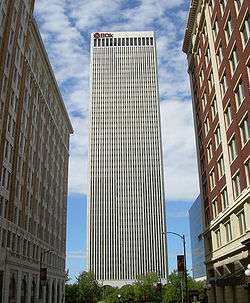BOK Financial Corporation
 | |
| Public company | |
| Traded as |
NASDAQ: BOKF Russell 1000 Index component |
| Industry | Banking |
| Founded |
1910, as Exchange National Bank of Tulsa 1990, as BOK Financial Corporation |
| Headquarters | Tulsa, Oklahoma, U.S. |
Key people |
George Kaiser, Chairman Steven G. Bradshaw, CEO & President Steven E. Nell, CFO |
| Total assets |
|
| Total equity |
|
| Owner | George Kaiser (60%) |
Number of employees | 4,930 (2017) |
| Website |
www |
|
Footnotes / references [1] | |
BOK Financial Corporation is a bank holding company headquartered in the BOK Tower in Tulsa, Oklahoma. The company is 60% owned by George Kaiser, who acquired the bank in 1991 from the FDIC. It is the largest bank in Oklahoma, with 14% of the total deposits in the state. As of December 17, 2017, 17% of its loan portfolio was to borrowers in the petroleum industry.
BOK is an acronym for "Bank of Oklahoma".
The company operates 7 banks with branches in 8 states: Bank of Oklahoma, Bank of Texas, Bank of Albuquerque, Bank of Arizona, Bank of Arkansas, Colorado State Bank and Trust, and MoBank. It also operates TransFund, Cavanal Hill Investment Management, BOSC, Inc. and the Milestone Group.
History
BOK Financial traces its roots to the Exchange National Bank of Tulsa, which was formed in 1910 when 4 oil investors bought the assets of Farmers National Bank, which suffered from bank failure.[2] One of the bank's major investors was Harry F. Sinclair, who became the president of the bank.[3]
In 1917, Exchange National Bank of Tulsa began construction of a headquarters building in Tulsa at Third Street and Boston Avenue. In 1928, the bank constructed a 28-story tower adjacent to the initial building. The combined structure, since renamed the 320 South Boston Building, remained the tallest building in Tulsa until 1967.[4]
In 1933, during the Great Depression, several Tulsa oil men, including William G. Skelly, Harry Sinclair, J.A. Chapman, and H.G. Barnard, invested $6.5 million of their own wealth into the bank to keep it afloat. As a result, it was able to become a major player in the early 1930s oil boom. In 1933, it was reorganized as the National Bank of Tulsa (NBT).[3][5]
In 1945, the bank was one of the largest sellers of War bonds.[3]
In 1975, NBT changed its name to Bank of Oklahoma (BOK). The following year, BOK began moving its headquarters employees into the new BOK Tower. Also in 1975, the bank installed the first automated teller machine in Oklahoma.[3]
In 1979, the bank reached $1 billion in assets.[3]
In 1984, the bank merged with Fidelity of Oklahoma and reached $3 billion in assets.[3]
In 1986, the bank received $130 million from the Federal Deposit Insurance Corporation (FDIC) and reported a net loss of $139 million.[6]
On June 7, 1991, when the bank had just under $2 billion in assets, it was acquired by George Kaiser for $61 million in a sale facilitated by the FDIC. Under Kaiser's ownership, BOK began an aggressive expansion effort with the strategy to locate in growing markets near Oklahoma.[3][6]
In 1994, the bank entered Arkansas with an acquisition of a bank that became the Bank of Arkansas.[3]
In 1998, the bank formed the Bank of Albuquerque with the acquisition of 17 branches in New Mexico.[3]
In 2003, the bank formed Colorado State Bank and Trust and entered the Denver market.[3]
In 2004, the bank formed Bank of Arizona and entered the Phoenix market.[3]
In November 2008, the bank declined to receive a capital investment from the United States Department of the Treasury as part of the Troubled Asset Relief Program, making it the largest bank in the United States to do so.[3][7]
In 2007, the company expanded in Texas with the acquisition of Worth Bancorporation.[8]
On August 19, 2012, the company acquired Milestone Group, a wealth management firm, in its first acquisition since 2007.[9]
In March 2014, the company announced the acquisition of MBM Advisors, Inc. of Houston, Texas.[10]
In November 2016, the company acquired MBT Bancshares, the parent company of Missouri Bank and Trust of Kansas City, informally known as "mobank".[11]
Sponsorships
In 2005, the company acquired the naming rights for the BOK Center, for $11 million.[12]
References
- ↑ "BOK Financial Corporation 2017 Form 10-K Annual Report". U.S. Securities and Exchange Commission.
- ↑ "OKLAHOMA BANKS CLOSED: State Concern Forced to the Wall by Failure of National Bank". The New York Times. December 15, 1909. (subscription required)
- 1 2 3 4 5 6 7 8 9 10 11 12 WINSLOW, LAURIE (November 14, 2010). "Bank of Oklahoma celebrates 100 years". Tulsa World.
- ↑ "Historic Tulsa: The Bank at 320 South Boston".
- ↑ GRAHAM, GINNIE (August 30, 2008). "Tulsa weathered other failures". Tulsa World.
- 1 2 HARDIMAN, SAMUEL (June 7, 2016). "BOK Financial experiences 25 years of growth under George Kaiser". Tulsa World.
- ↑ "BOK FINANCIAL CORP. CHOOSES NOT TO PARTICIPATE IN TREASURY'S CAPITAL PURCHASE PROGRAM" (Press release). U.S. Securities and Exchange Commission. November 12, 2008.
- ↑ "BOK Financial Acquires Worth Bancorporation, Inc. to Continue Fort Worth Expansion" (Press release). Business Wire. March 12, 2007.
- ↑ "BOK Financial Acquires The Milestone Group" (Press release). Business Wire. August 19, 2012.
- ↑ "BOK Financial Announces Acquisition of MBM Advisors" (Press release). Business Wire. March 4, 2014.
- ↑ "BOK Financial Receives Regulatory Approvals to Acquire MBT Bancshares" (Press release). GlobeNewswire. November 16, 2016.
- ↑ Mecoy, Don (October 28, 2005). "BOK will pay $11 million to name Tulsa arena". The Oklahoman.
External links
- Business data for BOK Financial Corporation: Google Finance
- Yahoo! Finance
- Bloomberg
- Reuters
- SEC filings